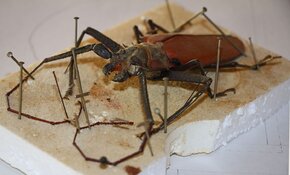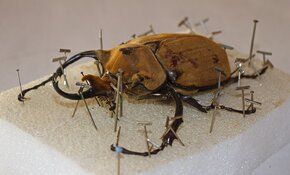Barry's picture of that big beetle reminded me of this.
This is not a wood working question but I know there are quite a few folks on here who cast various things in resin. When my family lived in the Canal Zone, one thing we got into was going out at night searching for any of the large beetles that would be attracted to the lights. I'd inject them with formaldehyde and then pin them onto a styrofoam board and let them dry. Then we'd pour them in clear two-part epoxy. Dad would square them up on the band saw and we'd sand and polish them in the wood shop at the high school. But we often had a problem. The epoxy was exothermic so generated heat as it cured. That heat caused the air inside the beetles to expand. Since the epoxy was curing, the air had no where to escape and would flow around the beetle resulting in a silver lining, which more or less ruined the whole thing. I always thought pouring them in a vacuum was the solution but we didn't have a vacuum chamber. I still have a few beetles that I'd like to preserve in clear resin and now I have a vacuum chamber. My Canal Zone experience was over 40 years ago so I'm hoping there have been advancements in resins and techniques. So I'm posting this thread asking for any advice or related links from people who have cast resin in a vacuum chamber. Looking for advice about the type of resin, the source, techniques for pouring, especially about trying to minimize the air bubble and entrapped air problem. Thanks. Feel free to send me a message and we can take this off line so we don't tie up forum space too.



This is not a wood working question but I know there are quite a few folks on here who cast various things in resin. When my family lived in the Canal Zone, one thing we got into was going out at night searching for any of the large beetles that would be attracted to the lights. I'd inject them with formaldehyde and then pin them onto a styrofoam board and let them dry. Then we'd pour them in clear two-part epoxy. Dad would square them up on the band saw and we'd sand and polish them in the wood shop at the high school. But we often had a problem. The epoxy was exothermic so generated heat as it cured. That heat caused the air inside the beetles to expand. Since the epoxy was curing, the air had no where to escape and would flow around the beetle resulting in a silver lining, which more or less ruined the whole thing. I always thought pouring them in a vacuum was the solution but we didn't have a vacuum chamber. I still have a few beetles that I'd like to preserve in clear resin and now I have a vacuum chamber. My Canal Zone experience was over 40 years ago so I'm hoping there have been advancements in resins and techniques. So I'm posting this thread asking for any advice or related links from people who have cast resin in a vacuum chamber. Looking for advice about the type of resin, the source, techniques for pouring, especially about trying to minimize the air bubble and entrapped air problem. Thanks. Feel free to send me a message and we can take this off line so we don't tie up forum space too.



Last edited:



